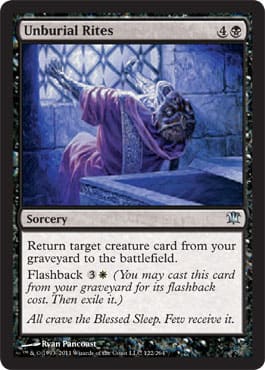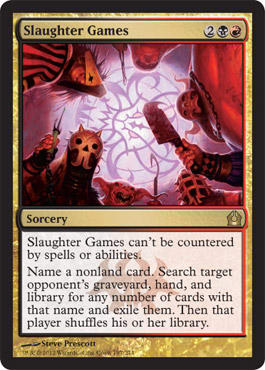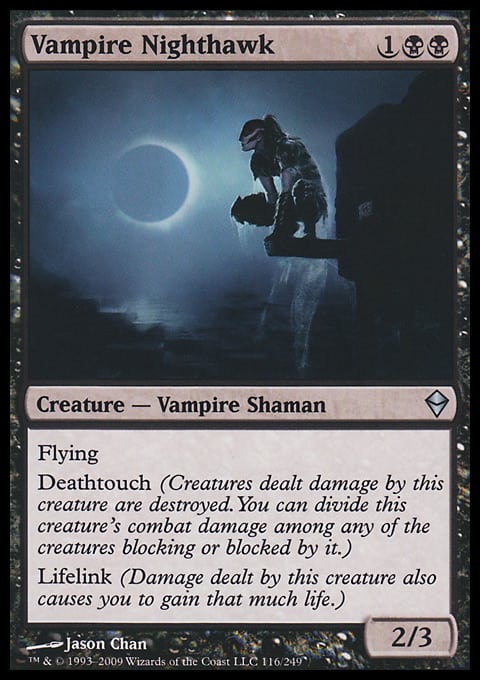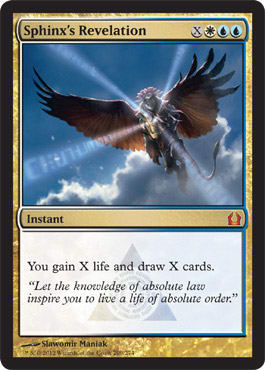Hey, everyone!
This week, I’m going to discuss some of the ideas I have had on how to improve the popular decks in Standard. In addition, I want to highlight some of the trends on the SCG Open and TCGplayer MaxPoint Series.
Grand Prix: San Antonio left us with quite the cliffhanger; B/R Zombies is very good, but can it be beaten? It’s difficult to suggest any of the decks from the Top 16 because they will need to consistently beat Zombies to be a reasonable choice going forward.
To illustrate my point, Conley Woods had an innovative Unburial Rites midrange deck, but he was taken down by B/R Zombies in the Top 4. Although he had a good weekend, playing his deck card for card is like bringing a musket to a gunfight. We need to make some adjustments with any deck to have the best chance in future events.
Before I go into the specific decklists, there are some cards that have risen in value recently. I typically like to build for metagames with a best deck in this way.
When making changes to decks, I will be keeping these cards in mind:
- Silklash Spider – I read an article by Sam Black that uttered these two words, and my world was turned upside-down. In my last article, I mentioned the issue of blocking both Falkenrath Aristocrat and Thundermaw Hellkite. One of them flew while the other punished flyers—what do we do? Play creatures with reach!
- Curse of Death's Hold – Not only does this stop Falkenrath Aristocrat, it’s also not embarrassing against G/W Aggro and helps the early Zombies from making an impact in the late game. Standard has plenty of sweet 5-drops, and it will take time to see which ones are truly the cream of the crop.
- Drogskol Reaver – This creature doesn’t die to the popular removal such as Selesnya Charm and Ultimate Price. I still see value in Ultimate Price going forward because there are too many Zombies and copies of Huntmaster of the Fells to warrant main-decking Victim of Night. Costing

 is also prohibitive, making it a weak choice for midrange strategies.
is also prohibitive, making it a weak choice for midrange strategies. - Slaughter Games – I know this card is horrible against Zombies, but we need effects to fight other decks in the room. It still serves the purpose of dealing with the hasty creature your hand can’t beat. For example, if you have an Ultimate Price in hand, naming Falkenrath Aristocrat could save you the game because you can deal with Thundermaw Hellkite and Hellrider. Despite the slight benefit, it’s pretty bad against a deck as aggressive as Zombies, but it at least has a use.
- Pillar of Flame – This one is pretty obvious since it’s the most efficient way of dealing with Gravecrawler and Geralf's Messenger. It does have the drawback of being weak against control.
Since the rise of Zombies, we also need to evaluate the staples of the format. Some of the cards you previously held sacred may not be so hot against this new aggro menace.
- Supreme Verdict – This card is awkward against B/R Zombies because it doesn’t kill Falkenrath Aristocrat, Geralf's Messenger, and Gravecrawler, while Terminus does. It still may be good enough because Terminus costing 6 mana and the miracle ability being volatile is a huge tradeoff.
- Counterspells – The best deck in the format plays Cavern of Souls and quick monsters, so it seems natural to cut back on permission.
With these things in mind, let’s get to changing the format!
Jund
The deck I want to talk about is Jund since it is able to play with the most hate cards.
"Standard Jund"
- Creatures (16)
- 3 Thundermaw Hellkite
- 3 Vampire Nighthawk
- 4 Huntmaster of the Fells
- 4 Thragtusk
- 2 Olivia Voldaren
- Planeswalkers (2)
- 2 Garruk, Primal Hunter
- Spells (17)
- 2 Ultimate Price
- 1 Mizzium Mortars
- 2 Dreadbore
- 2 Slaughter Games
- 4 Farseek
- 4 Pillar of Flame
- 2 Rakdos Keyrune
- Lands (25)
- 1 Forest
- 1 Mountain
- 1 Swamp
- 2 Kessig Wolf Run
- 4 Blood Crypt
- 4 Dragonskull Summit
- 4 Overgrown Tomb
- 4 Rootbound Crag
- 4 Woodland Cemetery
- Sideboard (15)
- 2 Silklash Spider
- 1 Curse of Death's Hold
- 1 Vampire Nighthawk
- 1 Sever the Bloodline
- 2 Underworld Connections
- 1 Golgari Charm
- 1 Slaughter Games
- 1 Vraska the Unseen
- 3 Duress
- 2 Liliana of the Veil
The most interesting thing about this deck is the main-decked Slaughter Games. I justified this because most of my Jund decks played Rakdos's Return, and this serves a very similar function. Since the control decks are based around Sphinx's Revelation, this seems to be the natural evolution to keep up with blue. Why play Rakdos's Return when most G/W decks play Loxodon Smiter and control decks can draw more cards than you make them discard? It can also be a dead draw against Zombies since the best you hope for is to hit the 4- and 5-drops (Slaughter Games names them in most cases). Neither of the cards is perfect against B/R Zombies since you can name Hellrider and see a hand full of Falkenrath Aristocrats or discard the opponent’s hand only to die to a top-decked Thundermaw Hellkite.
Thundermaw Hellkite is here as a quick clock since you need to be more aggressive against control decks. When Zombies returns (as they often do), you need to play Pillar of Flame, which makes you worse against many of the other decks in the room. Can you honestly out-control a Sphinx's Revelation deck playing a bunch of cheap removal spells in the main? For this reason, I think the Hellkite will become even more popular than it already is. It’s not amazing against Zombies, which is the reason I have exactly three 5-drops in my sideboard that are very good against them.
Silklash Spider is everything you want in a card; it deals with Thundermaw Hellkite and Falkenrath Aristocrat. I chose to stick them in the sideboard because they don’t do very much in certain matchups. This is a very embarrassing 5-drop against Bant control, so I chose more proactive cards in their place, such as the Hellkite. If Zombies is expected to be a huge percentage of the decks you play against, I would play a couple in the main instead of Hellkite.
Vampire Nighthawk is another card that becomes stronger when the best deck is aggressive. While it doesn’t block Thundermaw Hellkite on the first try, it can put a damper on the early assault. It also goes well with Kessig Wolf Run since it has deathtouch and lifelink. Try blocking this guy in the late game, and see all of the things that go wrong. You only need to deal 1 damage to the blocking creature since it has deathtouch (the rest goes to the opponent).
Jund was also missing an early play when you don’t draw Farseek, so the Nighthawk helps your curve. I also like it because your creatures become more powerful when the overall game plan is proactive. A few pecks from the Nighthawk seem harmless until you drop a Hellkite to put the opponent on a quick clock.
The card I cut to make way for these new cards is Bonfire of the Damned. While this was not an easy decision, I think it’s warranted in the current metagame. The damage-based removal is weak against Zombies unless it exiles them. Jund has a tough time fitting Pillar of Flame, Bonfire of the Damned, and Dreadbore in the main deck without sacrificing the control matchup entirely. I did add one Mizzium Mortars to compensate for the loss of the sweeping effect.
Overall, I think this is a good deck for the metagame, and the main message is to have a semi-proactive game plan against the control decks that will prey on the anti-Zombie decks.
Door to Nothingness
Next up, we have the deck Ali Aintrazi played to the Top 4 of the SCG Open: Baltimore:
"Ali Aintrazi’s Five-Color"
- Creatures (10)
- 4 Huntmaster of the Fells
- 4 Thragtusk
- 1 Gisela, Blade of Goldnight
- 1 Griselbrand
- Planeswalkers (2)
- 1 Garruk, Primal Hunter
- 1 Nicol Bolas, Planeswalker
- Spells (22)
- 1 Abrupt Decay
- 1 Ultimate Price
- 3 Sphinx's Revelation
- 1 Supreme Verdict
- 1 Terminus
- 2 Rakdos's Return
- 3 Lingering Souls
- 4 Farseek
- 1 Detention Sphere
- 2 Curse of Death's Hold
- 3 Chromatic Lantern
- Lands (26)
- 1 Alchemist's Refuge
- 1 Blood Crypt
- 1 Dragonskull Summit
- 1 Glacial Fortress
- 1 Hallowed Fountain
- 1 Isolated Chapel
- 1 Kessig Wolf Run
- 1 Steam Vents
- 1 Sulfur Falls
- 2 Hinterland Harbor
- 2 Rootbound Crag
- 2 Sunpetal Grove
- 3 Cavern of Souls
- 4 Overgrown Tomb
- 4 Temple Garden
- Sideboard (15)
- 1 Door to Nothingness
- 2 Centaur Healer
- 2 Rhox Faithmender
- 1 Curse of Echoes
- 2 Rest in Peace
- 1 Abrupt Decay
- 2 Tragic Slip
- 1 Jace, Memory Adept
- 3 Duress
Quick notes about the deck:
- Ali beat six Zombie decks in the Swiss and didn’t lose to a single one!
- This deck shows you don’t have to play B/R in order to be competitive. I love that this deck plays so many wild spells such as Griselbrand, Gisela, Blade of Goldnight, Nicol Bolas, Planeswalker, and Door to Nothingness.
- This deck pushes the envelope on mana bases in the format. Ali showed us we only need four Farseek, twenty-six lands, and three Chromatic Lantern to play whatever we want.
- Sphinx's Revelation allowed Ali to build this deck with a toolbox style. Notice all of the singleton removal spells because they are all narrow. The ability to draw your deck allows you have more focused spells for the right situation.
- Who says you can’t play five colorless lands in a deck with Griselbrand, Gisela, Garruk, Primal Hunter, and Nicol Bolas!?
- The SCG Open was ten rounds of Swiss, meaning he won the first nine rounds; this deck has consistency.
Naya
The winner of the SCG Open: Baltimore was playing Naya (Pat Shifflett):
"Pat Shifflett’s Naya"
- Creatures (24)
- 4 Avacyn's Pilgrim
- 4 Huntmaster of the Fells
- 4 Loxodon Smiter
- 4 Restoration Angel
- 4 Thragtusk
- 4 Thundermaw Hellkite
- Spells (12)
- 4 Selesnya Charm
- 4 Bonfire of the Damned
- 4 Farseek
- Lands (24)
- 3 Mountain
- 4 Forest
- 2 Kessig Wolf Run
- 3 Clifftop Retreat
- 4 Cavern of Souls
- 4 Rootbound Crag
- 4 Temple Garden
- Sideboard (15)
- 3 Angel of Serenity
- 2 Zealous Conscripts
- 2 Rest in Peace
- 2 Garruk Relentless
- 2 Garruk, Primal Hunter
- 4 Pillar of Flame
Quick notes:
- Bonfire of the Damned pairs well with Selesnya Charm because one kills small creatures and the other kills bombs.
- Selesnya Charm kills Falkenrath Aristocrat as long as it has exalted or a Human is sacrificed to give it indestructibility.
- This feels like the natural evolution of Conley’s deck from Grand Prix: San Antonio because Unburial Rites is weak in a field of aggressive Zombies. The only black card that impressed me were the sideboard Slaughter Games.
- Four Pillar of Flames in the sideboard is an interesting way to fight Zombies without packing your deck full of useless removal against control. Since there are so many mana sources, it’s important for your spells to have a strong impact on the game to avoid flooding. I could see a couple of Oblivion Rings making the cut over Selesnya Charms or Bonfire of the Damned to make the removal suite more versatile.
- The combination of Loxodon Smiter and Thundermaw Hellkite can make for a quick clock. This is a trend worth noting for building a midrange deck of your own.
Note: Zombies players occupied nine out of sixteen of the top slots at the SCG Open. No other aggressive deck managed to crack Top 16.
American Midrange
The TCGplayer 50K invitational painted a different picture of Standard, as American Midrange made quite the splash. It’s no surprise that the deck was able to perform well because Snapcaster Mage plus Pillar of Flame in a proactive shell can halt a Zombie horde in a pinch.
Here’s the winning decklist from the TCG 50K Championship played by Ryan Hipp:
"Ryan Hipp’s American Midrange"
- Creatures (14)
- 3 Restoration Angel
- 3 Thundermaw Hellkite
- 4 Snapcaster Mage
- 4 Geist of Saint Traft
- Spells (22)
- 1 Essence Scatter
- 1 Feeling of Dread
- 1 Izzet Charm
- 1 Sphinx's Revelation
- 1 Syncopate
- 1 Unsummon
- 3 Azorius Charm
- 3 Dissipate
- 3 Searing Spear
- 2 Bonfire of the Damned
- 3 Pillar of Flame
- 2 Detention Sphere
- Lands (24)
- 1 Island
- 1 Moorland Haunt
- 1 Slayers' Stronghold
- 2 Cavern of Souls
- 3 Clifftop Retreat
- 4 Glacial Fortress
- 4 Hallowed Fountain
- 4 Steam Vents
- 4 Sulfur Falls
- Sideboard (15)
- 1 Curse of Echoes
- 1 Detention Sphere
- 1 Dispel
- 1 Feeling of Dread
- 1 Ghost Quarter
- 1 Izzet Staticaster
- 2 Negate
- 2 Rest in Peace
- 1 Saving Grasp
- 1 Sphinx's Revelation
- 2 Supreme Verdict
- 1 Tamiyo, the Moon Sage
Quick notes:
- Here, we see another take on Pillar of Flame plus Thundermaw Hellkite.
- Slayers' Stronghold is awesome with Geist of Saint Traft.
- Sphinx's Revelation is great here because you need enough lands to consistently play Thundermaw Hellkite on turn five anyway (which is at least twenty-four).
- The sideboard has a ton of technology: Izzet Staticaster, Saving Grasp, and Curse of Echoes. Curse is effective at utterly destroying opposing blue decks and is becoming a popular sideboard singleton.
- Izzet Staticaster blocks Gravecrawler and Diregraf Ghoul, kills Knight of Infamy, and threatens to kill Falkenrath Aristocrat. The 1 damage can also help a Pillar of Flame finish off a larger creature, and the Staticaster can be flickered to great effect with Restoration Angel.
R/W/U Flash
Another style of R/W/U deck was designed by Gerry T, who placed in the Top 4:
"Gerry T’s R/W/U Flash"
- Creatures (12)
- 4 Augur of Bolas
- 4 Restoration Angel
- 4 Snapcaster Mage
- Spells (23)
- 1 Counterflux
- 1 Dissipate
- 1 Izzet Charm
- 1 Rewind
- 2 Think Twice
- 3 Sphinx's Revelation
- 4 Azorius Charm
- 4 Thought Scour
- 1 Supreme Verdict
- 4 Pillar of Flame
- 1 Runechanter's Pike
- Lands (25)
- 1 Mountain
- 1 Plains
- 2 Island
- 1 Moorland Haunt
- 4 Clifftop Retreat
- 4 Glacial Fortress
- 4 Hallowed Fountain
- 4 Steam Vents
- 4 Sulfur Falls
- Sideboard (15)
- 2 Dispel
- 1 Drogskol Reaver
- 4 Izzet Staticaster
- 3 Jace, Memory Adept
- 1 Negate
- 2 Oblivion Ring
- 1 Rest in Peace
- 1 Supreme Verdict
Quick notes:
- Gerry lost to R/W/U Geist in the semis, which can be expected, as he was heavily planning for Zombies. That’s not a creature you can beat with a control deck on accident.
- There are a lot of sweet counters in this list: Dissipate, Izzet Charm, Rewind, and Counterflux. He excludes Syncopate since it’s weak in the late game and counters aren’t designed to fight the creature decks that include Cavern of Souls anyway.
- Like Ali Aintrazi, Gerry took the toolbox approach with Sphinx's Revelation and jammed a bunch of singletons for maximum versatility—for example, Runechanter's Pike.
- In order to take a more proactive approach in the control mirror, Gerry played three copies of Jace, Memory Adept in the sideboard. Keep this card in mind if Bant control with Elixir of Immortality is big in your area.
- Drogskol Reaver replaced Angel of Serenity in the sideboard as the fatty of choice for reasons mentioned above.
- Dispel counters Sphinx's Revelation and protects it for the cheapest cost (allowing you to pay more for X).
- You will probably notice a trend of going down to one Runechanter's Pike because everyone knows Rest in Peace is good against W/U Flash variants. This will probably not be the case in the future, as many Flash decks even play it in their sideboards at the moment.
Rundown
The 50K MaxPoint Series had a measly one B/R Zombies deck in the Top 8. This can be explained by the large number of R/W/U decks—they can seamlessly play a game that is favored against Zombie hordes.
Overview of the weekend:
- Bant control appears to be in a bad spot, as the high end from B/R Zombies—as well as R/W/U Geist—give it fits.
- Ali’s five-color control deck appears to be well-positioned to become the premier Sphinx's Revelation control strategy.
- Zombies failed to win the TCGplayer and SCG tournaments last weekend, but it still had plenty of success.
- Thundermaw Hellkite is a great win condition in red, as it provides a proactive strategy combined with Pillar of Flame to handle Zombies.
- Keep an eye on Curse of Death's Hold and Silklash Spider in the coming weeks.
- American Midrange is reemerging since it can effortlessly cast Pillar of Flame. This means you need to be prepared for Geist of Saint Traft.
That’s all for this weekl thanks for reading!
-Kyle
kmboggemesATgmailDOTcom


























